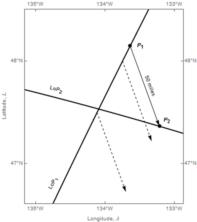
NavList:
A Community Devoted to the Preservation and Practice of Celestial Navigation and Other Methods of Traditional Wayfinding
Re: The Running Fix on an Ellipsoid
From: Gary LaPook
Date: 2017 Feb 4, 07:44 +0000
From: Brad Morris <NoReply_Morris@fer3.com>
To: garylapook@pacbell.net
Sent: Friday, February 3, 2017 7:13 PM
Subject: [NavList] Re: The Running Fix on an Ellipsoid
From: Gary LaPook
Date: 2017 Feb 4, 07:44 +0000
Um... much ado about nothing. I read the paper and it is a whole lot easier to just advance the LOP to obtain the running fix. If your look at the diagram explaining the process it is simply showing the standard advancing the LOP to cross the second LOP. Remember, the first LOP is a line, and infinite set of points, that are advanced until one of those points intersects with the second LOP and that is exactly what the diagram shows if the entire LOP had been advanced the same intersecting point would have been found. If there is any greater accuracy to the complex mathematical process it is swamped by the normal uncertainty of the underlying celestial observations.
gl
From: Brad Morris <NoReply_Morris@fer3.com>
To: garylapook@pacbell.net
Sent: Friday, February 3, 2017 7:13 PM
Subject: [NavList] Re: The Running Fix on an Ellipsoid
Robin
Thank you for humoring me.
One look at the image explains it all. That's outstanding.
Well done sir!
Brad
On Feb 3, 2017 3:39 PM, "Robin Stuart" <NoReply_Stuart@fer3.com> wrote:
Brad,It appears that the pdf is freely available at the link given by Andres. The underlying idea is amazing only in its bone-headedness and you’d wonder why people ever attempted to advance LoP’s on the sphere in the first place and how they got it so wrong in the process.The procedure given in the paper is numerical but can be described in graphical terms. Draw the two LoP’s just as you obtain them. Then find a point P1 on the first LoP and P2 on the second separated by the known course and distance of the run. No need to advance anything. This is shown in the attached file.It ultimately boils down to numerically finding the root of a non-linear equation in just one variable and is easy to achieve by standard iterative methods. The dotted arrows in the diagram are starting values used to initialize the iterative procedure. What might be a bit surprising is that, thanks in part to some fairly recent developments for calculating ellipsoidal arc lengths, it is feasible in practice to push this forward for the ellipsoid and it’s only modestly more complicated than the case of a sphere.Regards,Robin Stuart
Attached File:







